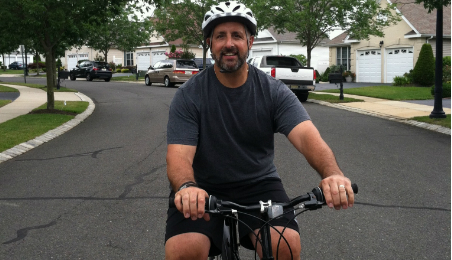DBS Allows Retired NYPD Officer to Return to His Long Rides Without Disruptive Tics and Tremors
When retired New York City police officer Michael Toscano was first diagnosed with Parkinson’s disease (PD) 16 years ago, his life drastically changed. At only 34-years-old, he began the arduous, oftentimes unpredictable, treatment for the progressive neurological disorder to sustain a somewhat normal lifestyle.
 “Ever since I can remember, my dad has had PD,” says his youngest daughter, Gina. She was only 3 when he was first diagnosed.
“Ever since I can remember, my dad has had PD,” says his youngest daughter, Gina. She was only 3 when he was first diagnosed.
Seeking Treatment Beyond Medication
The road to recovery has been a difficult one, fraught with its share of impingements and challenges. Keeping PD’s symptoms under control involves the most effective drug on the market levodopa, which comes with its share of side effects including as dyskinesia and dystonia. While modification of levodopa can alter the subsequent tics and shakes, gaining control over these side effects is not simple.
Michael required an extensive daily regimen of pills. On top of the PD medications, Michael needed sleeping pills in order to get a decent night’s rest, since the other medication “wired him up.” “I told my doctor I don’t want to take any of this anymore,” Michael said alongside his wife Donna.
While there is no cure for PD at this time, remarkable strides have been made in the treatment of its symptoms. Michael was a candidate for deep brain stimulation (DBS). After completing the two-step surgery, Michael could once again ride his bike, play with his dog, and regain a sense of independence.
Steps to Wellness
Patients who are considering DBS first meet with their neurologist to determine if this treatment is right for them. Before being considered for the procedure, Michael met with neurologists and neurosurgeons specializing in movement disorders to discuss the benefits and risks. Upon further review of MRI and CT scans, Michael was found to be an appropriate candidate for DBS.
Michael’s neurosurgeon Brian H. Kopell, MD, the Director of Mount Sinai’s Center for Neuromodulation, has been at the forefront of restorative neuroscience and neuromodulation technologies, including DBS. Since assuming his role at Mount Sinai in 2012, he has brought DBS to a whole new level, using intraoperative imaging to identify the sites of irregularity, in addition to regular microelectrode recording. This makes surgery quicker and safer for patients. However, Dr. Kopell’s goal for Michael went above a quick and safe recovery. “This operation isn’t about getting them out of the wheelchair,” says Dr. Kopell. “It’s about getting them back onto the golf course – and in Michael’s case, we want to get him back onto his bicycle.”
The first step consisted of a four-hour surgery in which Dr. Kopell implanted the electromagnetic probes, known as leads, onto the area of the brain causing irregular impulses. With the leads in place and evaluations performed by Dr. Kopell and neurologist Catherine Cho, MD completed, Michael was on his way home the next day. After Michael returned for the second step and then a third, which involved inserting the system’s generator into his chest and setting him up with a special remote control that can be used to regulate the frequency of the electronic impulse, allowing him to reemerge into a life without disruptive tics and tremors.
DBS Gives Michael More Control of His PD
Not long after completing his DBS procedure, Michael was back on his bicycle, riding between 15 and 25 miles with his friends. “My wife wants me to go easy,” he admits with a coy smile. “I rode 25 miles yesterday. We were only supposed to ride 15, but it’s fun.” DBS has allowed Michael to resume a considerable degree of autonomy over his PD, something that was only imaginable until now. With DBS, the side effects of medication no longer have to play such a defining role in Michael’s life.
It all started with a consultation. A profoundly improved quality of life became possible for Michael when he was willing to seek options beyond medication. Michael had two goals when he completed his DBS: 1) to get back on his bike and 2) to help other people learn about DBS and how it gave him control of his PD.